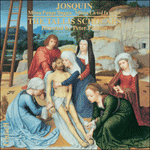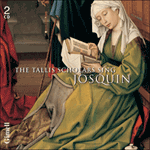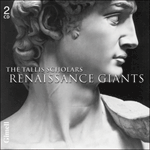Plainchant lies at the heart of the
Missa Pange lingua, but in this case the foundation melody, the Corpus Christi Hymn ‘Pange lingua gloriosi’, has been so thoroughly absorbed into Josquin’s music that only the sharp-eared will be alert to its presence. Where many Masses based on chant keep the parent melody in the foreground, Josquin instead uses its contours to govern only the progress of the melodic lines, with all manner of infilling and rhythmic elaboration added to camouflage its essential shape. Possibly the appeal of the work to modern audiences—it is Josquin’s most performed Mass—lies precisely in the way its variety and unity are kept in equilibrium: for all the music’s richness of invention, everything is contained within clearly perceptible bounds of possibility. Only the very opening of the Hymn melody stubbornly retains its identity: it sets each of the five movements in motion, and sometimes recurs at major structural divisions in the text: at ‘Qui tollis peccata mundi’ in the Gloria, for example, ‘Crucifixus’ in the Credo, and at the head of all three invocations of the Agnus Dei.
from notes by John Milsom © 1992
Le plain-chant se trouve au cœur de
Missa Pange lingua, mais là, la mélodie de base, le cantique du Corpus Christi «Pange lingua gloriosi», se trouve tellement absorbée dans la musique de Josquin que seules des oreilles averties pourraient la déceler. Tandis que de nombreuses messes basées sur le chant mettent la mélodie d’origine au premier plan, Josquin, lui, utilise ses contours pour donner une direction aux lignes mélodiques et il y ajoute toutes sortes de remplissage et d’élaborations rythmiques pour en camoufler la forme essentielle. Il est possible que l’attrait de cette œuvre pour les auditoires modernes (c’est la plus jouée des messes de Josquin) réside précisément dans l’équilibre qu’on y trouve entre variété et unité; malgré toute la richesse d’invention de la partition tout y est maintenu dans les limites clairement perceptibles du possible. Seul le tout début de la mélodie du cantique retient obstinément son identité, il ouvre chacun des cinq mouvements et reparaît parfois à certaines divisions structurelles importantes des textes; au «Qui tollis peccata mundi» au Gloria, par exemple, «Crucifixus» dans le Credo, et en tête des trois invocations de l’Agnus Dei.
extrait des notes rédigées par John Milsom © 1992
Français: Marie-Françoise Wilson
Der Gregorianische Gesang bildet den Mittelpunkt der
Missa Pange lingua. Doch hier ist die Grundmelodie, d. h. die Corpus-Christi-Hymne „Pange lingua gloriosi“, so sehr mit Josquins Musik verschmolzen, daß sie nur von einem scharfen Gehör entdeckt werden kann. Wo viele auf Gesang basierende Messen die Ausgangsmelodie in den Vordergrund stellen, verwendet Josquin deren Kontouren nur, um den Fortgang der melodischen Zeilen zu bestimmen, wobei alle möglichen Einfügungen und rhythmische Ausschmückungen hinzukommen, um die Grundmelodie zu kaschieren. Vermutlich liegt die Anziehungskraft dieses Werkes für die moderne Zuhörerschaft—es handelt sich um Josquins meistaufgeführte Messe—in der Art und Weise begründet, wie dessen Vielseitigkeit und Einheit im Gleichgewicht gehalten werden. Trotz des außerordentlichen Einfallsreichtums der Musik bewegt sich alles innerhalb der klar zu erfassenden Grenzen des Möglichen. Nur der Auftakt zur Hymne behält seine Identität hartnäckig bei. Er leitet jeden der fünf Sätze ein und kommt manchmal bei bedeutenden strukturellen Teilungen des Textes, wie zum Beispiel beim „Qui tollis peccata mundi“ des Glorias, beim „Crucifixus“ des Credos und zu Beginn der drei Anrufungen des Agnus Dei, wieder zum Vorschein.
aus dem Begleittext von John Milsom © 1992
Deutsch: Angela Grutters


 Josquin: Missa Pange lingua & Missa La sol fa re mi
Josquin: Missa Pange lingua & Missa La sol fa re mi Josquin: The Tallis Scholars sing Josquin
Josquin: The Tallis Scholars sing Josquin Renaissance Giants
Renaissance Giants
